Mouseketeer Alison's
Walt Dated World

Ride the Time Machine from the dawn of civilization to the beginning of our tomorrow.
Please show your support for this site by donating via the PayPal box .
Thank you!
Walt Dated World | home
CommuniCore East and West | Ellen's Energy Adventure | Horizons at Epcot | Journey Into Imagination | The Land at Epcot | Millennium Celebration/Millennium Village | Epcot Shops and Restaurants | Epcot Shows and Parades | Spaceship Earth/Earth Station | Universe of Energy Original Version | Wonders of Life | World of Motion
Spaceship Earth/Earth Station
Spaceship Earth/Earth Station
Please Help Walt Dated World
You can help support the Walt Dated World website in several different ways. Subscribe to and continue to watch the Walt Dated World YouTube channel, contribute via any PayPal button on the site or shop using the Amazon search box at the bottom of each page. Proceeds fund the continued operation of the site. Thank you!
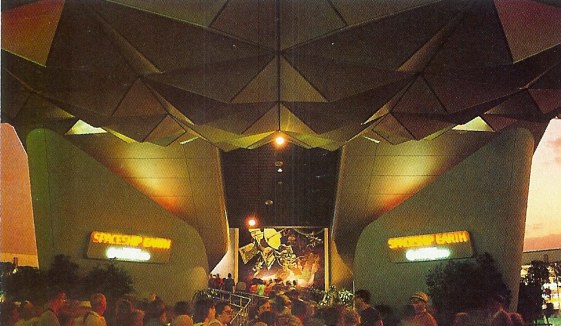
This icon at the entrance to Epcot is still featuring the story of human communication but the show has changed since the park first opened in 1982. It was first presented by Bell Systems before becoming AT&T. In 2005, sponsorship for Spaceship Earth transferred from AT&T to Siemens.
Spaceship Earth 1.0
There has been some discussion about who was the first narrator of Spaceship Earth. Most fans seem to believe that the voice of the original Spaceship Earth narrator was Vic Perrin, an actor who did many voiceovers and was the "Control Voice" on The Outer Limits television show. However, Disney Imagineer Marty Sklar did an interview saying that he didn't understand why everyone said the narrator was Vic Perrin; it was actually another actor named Larry Dobkin. To make things more confusing there are conflicting reports that there was another narrator after the first one but before the ride was rehabbed in May of 1986 with narration by Walter Cronkite. If anyone can provide audio proof of this, it would be most appreciated.
Jonathan Lim has this to add about Spaceship Earth 1.0: "The original Spaceship Earth narration starts with the phrase, 'Where have we come from, where are we going?'. This appears to be a reference to Where Do We Come From? What Are We? Where Are We Going?, one of the largest and most well-known paintings by Paul Gauguin. I've seen the painting in person myself, in March 2007. It was at the Art Institute of Chicago at the time. It is now back at its home at the Museum of Fine Arts in Boston."
Spaceship Earth: First Version Script
(Note: This comes from very a very poor audio source of the onboard narration and does not include most of the audio from individual scenes. Because of the controversy about who is narrating, I have left the identity on the script as "Narrator".)
Narrator: Where have we come from, where are we going? The answers begin in our past. In the dust from which we were formed, answers recorded on the walls of time. So let us journey into that past, to seek those walls, to know ourselves and to probe the destiny of our Spaceship Earth.
Narrator: Now, suns reverse, moons re-phase, let us return to ancient caves where first we learn to share our thoughts-and to survive.
Narrator: Where are we now? It is the waiting dawn where vast things stir and breathe. And with our first words and first steps, we draw together to conquer the mammoth beast. It is the dawn of a new beginning, the dawn of recorded time.
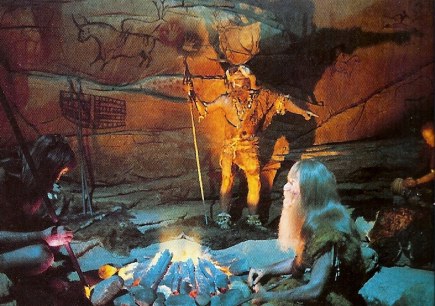
Narrator: On cave walls we inscribe our greatest triumphs, a growing record of our deeds, to share with others so they too may greet tomorrow's sun.
Narrator: Ages pass and more walls rise in the valley of the Nile. Man-made walls of hieroglyphics. Then with new symbols, we unlock our thoughts from chiseled walls and send them forth on papyrus scrolls.
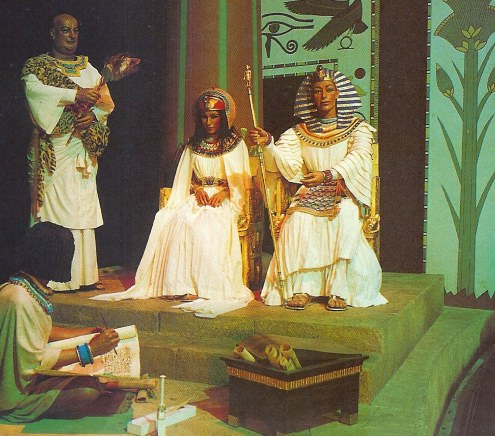
Narrator: On fine Phoenician ships, we take our scrolls to sea. Real scrolls simplified by an alphabet, eagerly shared at distant ports of call.
Narrator: Deep in the shadows of Mount Olympus, our alphabet takes route, flowering with new expression. Hail the proud Greeks: Aeschylus, Sophocles, Euripides. The theater is born.
Narrator: North, south, east, and west, all roads lead from Rome, a mighty network reaching across the land, welding far-flung garrisons into a growing empire.
Narrator: Glorious Rome, until consumed by the flames of excess. Imperial Rome, lost in the ashes of darkness.
Narrator: Far from the dying embers, Islamic wise men preserve ancient wisdom and weave a rich network of new knowledge linking east and west.
Narrator: In western abbeys, monks toil endlessly transcribing ancient wisdom into hand-penned books of revelation.
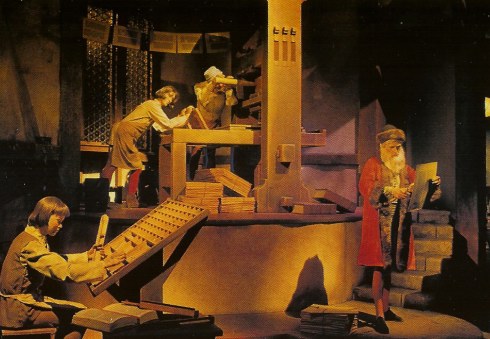
Narrator: At last! A new dawn emerges. The dawn of the Renaissance-and a wondrous machine performs as a thousand scribes. Now for all: the printed word.
Narrator: Our books fuel the fires of the Renaissance. It is a time to discover anew the worlds of poetry and philosophy, science and music. As our minds soar, our hands find new expression in the flourishing world of art. Behold, the majesty of the Sistine ceiling.
Narrator: The Renaissance: a beacon through the mists of time, guiding us to a new era. A time of invention and exploding communication.
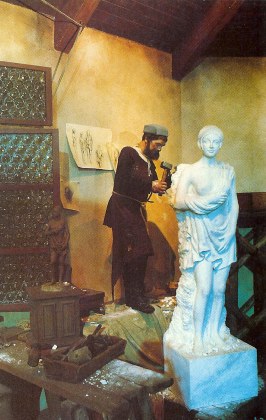
Narrator: With each day come more paths, more ideas, more dreams, and we build new machines: computer machines that think, that store, sift, sort, and count, that help us chart our course through an age of boundless information.
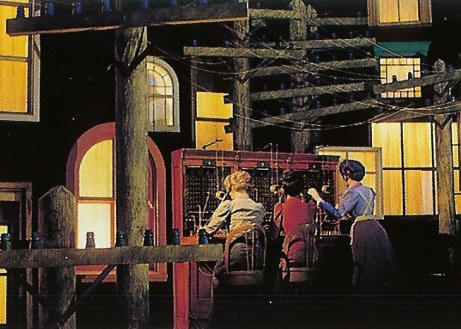
Narrator: With these machines comes a wondrous new network of communications, a vibrant maze of billions of electronic pathways stretching to the very edge of space.
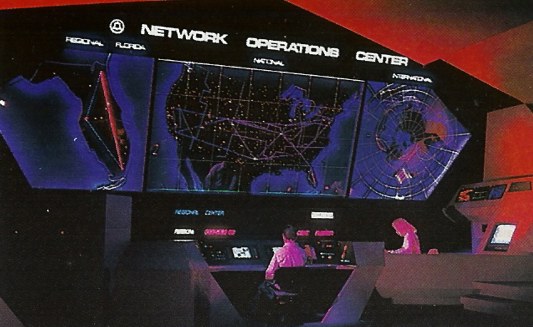
Narrator: Poised on the threshold of infinity, we see our world as it truly is: small, silent, fragile, alive, a drifting island in the midnight sky. It is our spaceship. Our Spaceship Earth.
Narrator: Now our Future World draws near -and we face the challenge of tomorrow. We must return and take command of our Spaceship Earth. To become captains of our own destiny. To reach out and fulfill our dreams.
Woman: GPC report. Odyssey is complete with position home.
Man: Can you switch to manual payload?
Woman: No problem. Manuel payload is activated. Signal from command execution.
Man: Roger. Are you getting video?
Woman: Affirmative. Delta camera is on and tracking.
Narrator: Our journey has been long. From primal caves we have ventured forth traveling the endless corridors of time seeking answers to our tomorrow. With growing knowledge and growing communication, we have changed our lives, changed our world.
Narrator: From the reaches of space to the depths of the sea, we have spun a vast electronic network linking ourselves as fellow passengers together, on Spaceship Earth.
(Ride vehicles pass by several TV screens.)
Narrator: Today our search for understanding is unbounded by space and time. Vast stores of information, knowledge from everywhere, standing ready at our beck and call to reach us in an instant. With our great network, we harness our knowledge, give it shape and form to serve us, to help create and communicate a better awareness of ourselves, and our world.
Narrator: Ours is the age of knowledge, the age of choice and opportunity.
Narrator: Tomorrow's world approaches, so let us listen and learn, let us explore and question and understand. Let us go forth and discover the wisdom to guide great Spaceship Earth through the uncharted seas of the future. Let us dare to fulfill our destiny.
Spaceship Earth 2.0
When Spaceship Earth emerged from renovation on May 29, 1986, it premiered with several changes. The first was that Walter Cronkite was the new narrator. The "dummy warning" message was added as the ride vehicles rotated backwards. A song called Tomorrow's Child was added as the Time Machines descended down to the unloading area. This popular song was written by Ron Ovadia and Peter Stougaard.
Female Announcer: AT&T welcomes you to Spaceship Earth and invites you to explore the story of communications. And now, your host, Walter Cronkite.
Walter Cronkite: For eons, our planet has drifted as a spaceship through the universe. And for a brief moment, we have been its passengers. Yet in that time, we've made tremendous progress in our ability to record and share knowledge. So let's journey back 40,000 years to the dawn of recorded history. We'll trace the path of communications from its earliest beginnings to the promise of the future.
Walter Cronkite: We have reached the dawn of recorded time, an age when mammoth creatures roam the land. But with spoken language, the ancient hunters learn to work together and meet the challenges of this hostile world.
Walter Cronkite: In primal tribes, the skills of survival are passed on to new generations through the art of storytelling. Not trusting this knowledge to memory alone, our ancestors create a lasting reminder with cave paintings.
Walter Cronkite: Ages later, stories and knowledge are transcribed in complex pictures and symbols. Hieroglyphics mark the rise of written language and soon with papyrus scrolls, the written word begins to travel out across the land.
Walter Cronkite: The value of writing for accurate record keeping appeals to Phoenician merchants. They create an alphabet. Simple enough for any to learn, and share this new tool at ports along the Mediterranean.
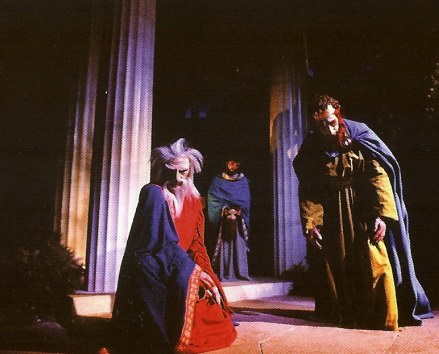
Walter Cronkite: In classic Greece, the alphabet grows and flowers with new expression and a new stage of storytelling emerges; a stage on which we examine our world and ourselves. The theater is born.
Walter Cronkite: The Romans build a mighty system of roads- a long distance network to carry laws and tidings over a far-reaching empire.
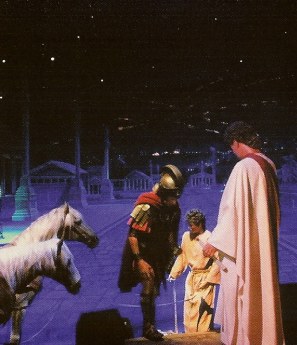
Walter Cronkite: Glorious Rome falls victim to the flames of excess. Ages of knowledge are lost or forgotten in the ashes.
Walter Cronkite: But all is not lost, for Islamic and Jewish scholars continue to preserve ancient wisdom in noble libraries. In their travels, they record knowledge, and share their findings with cultures east and west.
Walter Cronkite: In western abbeys, monks toil endlessly transcribing ancient writings into hand-penned books of revelation.
Walter Cronkite: The dawn of the Renaissance brings a wondrous new machine, the printing press. Now books and authors flourish as never before.
Walter Cronkite: The Renaissance, a time of renewed interest in the worlds of poetry and music, science, philosophy and art. Behold, the majesty of the Sistine ceiling.
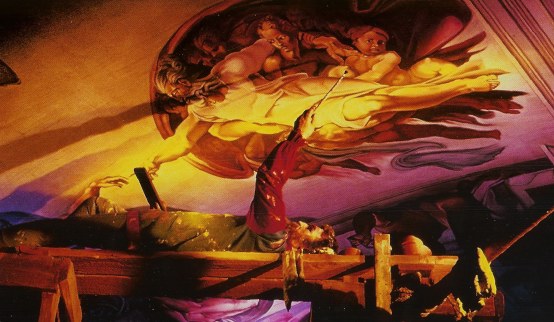
Walter Cronkite: On this wave of inspiration, we sail into a bold, new era. An age of astounding inventions and ever increasing progress in communications.
Walter Cronkite: With electronic communications, we can send messages instantly over long distances. Signals and voices criss-cross the nation. Radio and movies inform and entertain millions. Then television brings the world into our homes profoundly changing our perceptions of life itself.
Walter Cronkite: Instant communications create an ever-increasing flow of facts and figures. To manage this growing storehouse of information, we invent the computer. A revolutionary tool made practical by the tiny transistor.
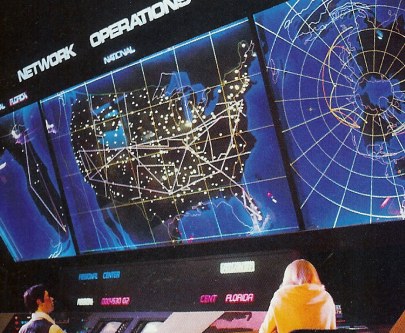
Walter Cronkite: Today, we're merging the technologies of communications and computers to store, process and share information. And we're creating a vast electronic network stretching from our homes to the reaches of space.
Female Announcer: Attention Time Travelers. Your Time Machine is about to rotate for your return to Earth. Please remain seated at all times.
(Instrumental version of Tomorrow's Child begins to play in the background.)
Walter Cronkite: We have entered a wondrous new age, the age of information. A time of new promise and new hope for ourselves and Spaceship Earth.
Walter Cronkite: Today, our search for understanding is unbounded by space and time. Centuries of information stand ready to reach us in an instant. Our link with the past, our hope for the future.
Walter Cronkite: In the information age, our knowledge and tools of communication will continue to grow and improve. We'll discover new ways to share our ideas and dreams, to create a better world for today, tomorrow and Tomorrow's Child.
(The Tomorrow's Child song becomes louder and can now be heard with vocals. A woman was heard as the lead singer while a children's chorus sang the parts in brackets)
Tomorrow's child.
(Tomorrow's child.)
Gathering gifts from our past.
Tomorrow's child.
(Tomorrow's child.)
Shaping a world that will last.
Holding the spark, as we embark,
on a great journey together we're learning
to reach for hope and desire.
Building a world to inspire.
Tomorrow's child, tomorrow's child,
shining a brand new way,
for the future world is born today.
(Born today.)
Tomorrow's child, lighting the path as we're going.
(Tomorrow's child.)
Tomorrow's child, seeing that knowledge keeps growing.
(Tomorrow's child.)
Searching through time, longing to find,
answers to guide us and dreams to unite us.
Reaching for hope and desire,
building a world to inspire.
Tomorrow's child, tomorrow's child,
shining a brand new way,
for the future world is born today.
(Born today.)
Walter Cronkite: Yes, Tomorrow's Child, embodying our hopes and dreams for the future. A future made possible by the information age. The technologies of this new era will extend our reach, expand the capabilities of the human mind and help us shape a better tomorrow.
Walter Cronkite: Ours is a time of unprecedented choice and opportunity, so let us explore and question and understand. Let us learn from our past and meet the challenges of the future, let us go forth and fulfill our destiny on Spaceship Earth.
Female Announcer: The people of AT&T thank you for traveling through Spaceship Earth and look forward to serving you in the Information Age. For a look at today's Information Age technologies, we invite you to visit FutureCom in CommuniCore West. When the doors of your vehicle open, please gather your personal belongings and step out onto the moving platform up ahead. The platform and your vehicle are traveling at equal speed.
Spaceship Earth 3.0
The Walter Cronkite version of Spaceship Earth was retained until 1994 when the ride was updated again with new scenes and new narration by Jeremy Irons. This new show version debuted on November 23, 1994. One of the biggest changes during the 1994 rehab was the deletion of the song Tomorrow's Child. For those who miss hearing Tomorrow's Child, it can still sometimes be heard as an instrumental at the entrance to Epcot. Long time park visitors were also disappointed that the newsboy during the newspaper scenes no longer screams "Extra! Extra! New York Daily!" Instead, he has different dialogue. According to Jeff Williams, Planner Associate of the WDW Facility Asset Management Office, the same person was used to perform the newly recorded audio except he was now 13 years older. The Jeremy Irons version of Spaceship Earth lasted until July 9, 2007. It was replaced by the Judi Dench version on February 15, 2008.
A giant Sorcerer Mickey hand holding out a wand with the year "2000" was added to the outside of Spaceship Earth in 1999 for the Millennium Celebration. After the year 2000, the sign was changed to say "Epcot". It was finally removed for good in 2007.
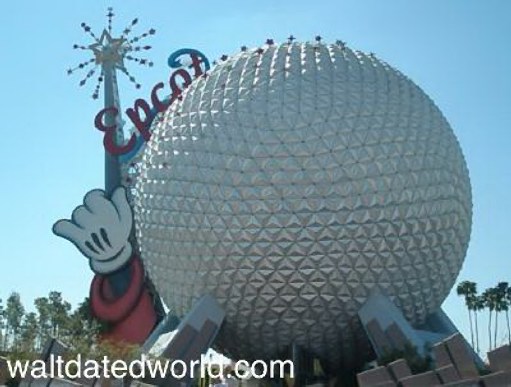
Female Announcer: AT&T welcomes you aboard Spaceship Earth. Journey with us now to the dawn of recorded as we explore the amazing story of human communication.
(Sounds of gibberish in many languages.)
Jeremy Irons: Like a grand and miraculous spaceship, our planet has sailed through the universe of time. And for a brief moment, we have been among its many passengers. From the very beginning, we have always sought to reach out to one another. To bridge the gaps between us. To communicate.
Jeremy Irons: Across a lonely, hostile planet, our early ancestors spread out in search of food and shelter.
Jeremy Irons: With the development of language came a vital key to our survival. For the first time, we could share and learn from one another. We bonded together in small tribes and prospered. No longer isolated, no longer alone.
Jeremy Irons: Ages later, the Egyptians invented the first written communications, complex language of hieroglyphic pictures and symbols. With the creation of papyrus scrolls, came the world's first piece of paper. Now, without ever leaving their palaces, pharaohs could deliver proclamations and decrees to subjects across the land.
Jeremy Irons: Phoenician merchants established the earliest commercial highways, trading goods and information at distant ports of call. To aid in record keeping, they created the first common alphabet and shared this new tool across the Mediterranean.
Jeremy Irons: In ancient Greece, the spoken word was elevated to a fine art. Philosophers debated with one another in plazas and storytellers found a new forum for personal expression. The theater was born.
Jeremy Irons: The mighty Roman empire bridged three continents with a vast system of roads, the fastest information highways the world had ever known. East, west, north, and south, all roads led to Rome.
Jeremy Irons: But these same roads were turned against Rome by invaders whose destruction left ages of knowledge and wisdom in the ashes that would become the Dark Ages.
Jeremy Irons: But all was not lost. For far across the land, from Cairo to Cordoba, Jewish teachers and Islamic scholars continued the quest for knowledge. In libraries of wisdom, they debated ideas and shared new discoveries with all who would listen.
Jeremy Irons: In western abbeys, monks toil endlessly in lonely isolation copying ancient books of wisdom and revelations for future generations.
Jeremy Irons: Finally, from the depths of the Dark Ages came the Age of Enlightenment - the Renaissance. And with this era, came a powerful new invention - the moveable type printing press.
Jeremy Irons: Scientists, explorers and scholars spread their discoveries in books and essays. Poets, musicians and artists fueled by the passion of the age created timeless works of beauty and majesty.
Jeremy Irons: On this wave of inspiration, we sailed into a bold, new era of communication bringing an explosion of tools and technologies which would bridge people around the world as never before. And as our appetite for information and knowledge grew, the world began to shrink.
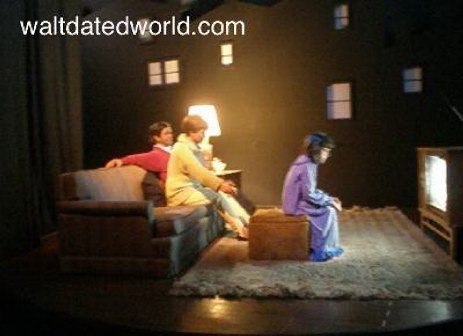
Jeremy Irons: Today, we possess the ability to connect with one another instantly anywhere on the planet.
Jeremy Irons: A new communications super network is being built before our eyes. Spaceship Earth glows with billions of interactions carrying news and information at the very speed of light.
(Sounds of gibberish.)
Jeremy Irons: But will these seemingly infinite communications become a flood of electronic babble? Or will we use this power to usher in a new age of understanding and co-operation on this, our Spaceship Earth.
Jeremy Irons: Physical distance is no longer a barrier to communication. Today, the entire world is our next door neighbor. Our news is their news, their news ours. We share our hopes and concerns with the whole planet. We truly live in a Global Neighborhood.
Jeremy Irons: Wondrous new tools will help us learn more about ourselves, each other, and the planet we share. Spaceship Earth will become our virtual classroom.
Jeremy Irons: As we greet the 21st century, yet another revolution in communication is upon us, as profound as all the progress that has come before. By using our new communication tools to build better bridges between us, we will discover we all share the common bonds of hope and sorrow, dreams and joys.
Jeremy Irons: Since the dawn of recorded time, communication has revolutionized our lives and changed our world. We now have the ability and the responsibility to build new bridges of acceptance and co-operation between us; to create a better world for ourselves and our children as we continue our amazing journey aboard Spaceship Earth.
Watch the Finale of Spaceship Earth 3.0 on the Walt Dated World YouTube Channel
Be Sure to Subscribe!
Earth Station
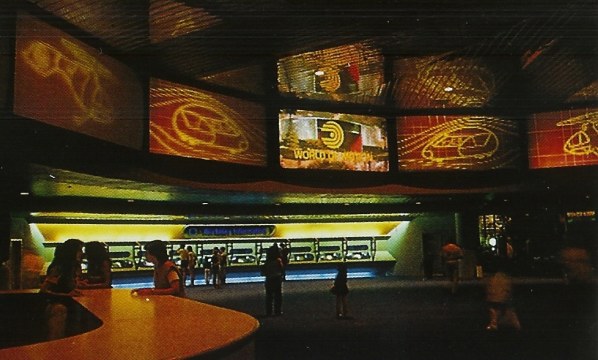
Located to the south of Spaceship Earth was Epcot's version of Guest Relations. Visitors could make restaurant reservations using the touch-sensitive WorldKey Information Service screens. The system could also be used to access information about all of the attractions, shops, and restaurants at Epcot.
There was also an option to get information from a cast member, who could see and talk back to the guests through a video camera and microphone. Earth Station also had overhead screens that depicted previews of the Future World pavilions during the EPCOT Earth Station Film.
Earth Station was replaced by the AT&T Global Neighborhood in 1995 and Guest Relations was relocated near Innoventions East. World Key Information Service screens could be found outside of the new Guest Relations area for awhile but they were gone for good by 1999.
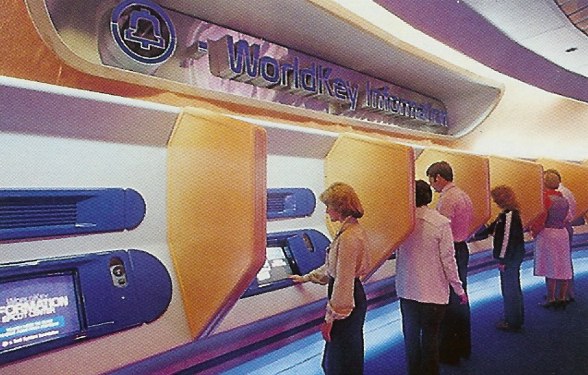
AT&T Sponsorship Signs
AT&T (The Bell System) sponsored Spaceship Earth from 1982-2002. The post show became the Global Neighborhood on February 2, 1995 and was known as AT&T's New Global Neighborhood from December, 1999 to April of 2004. Siemens then became the sponsor and changed the post show to Project Tomorrow: Inventing the Wonders of Tomorrow starting on April 25, 2007.
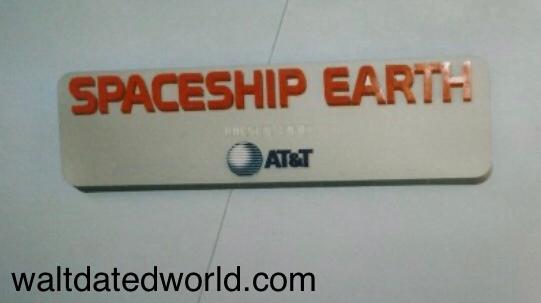
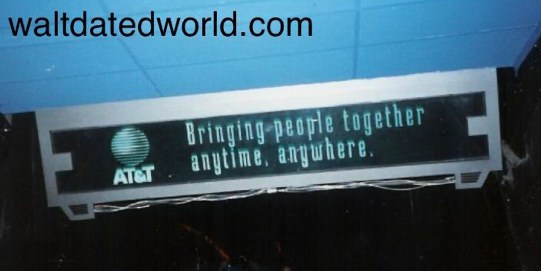
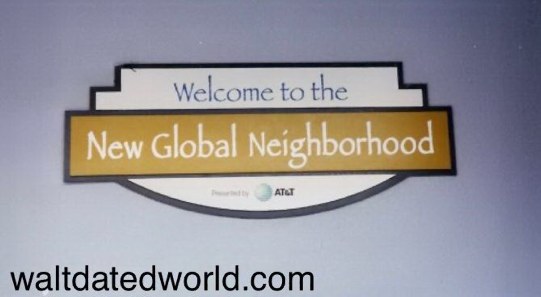
This is an unofficial fan site that is not affiliated with the Walt Disney Company or Disney theme parks. All copyrights acknowledged. Please respect the work I put into compiling both existing and my own information on this site by not linking to any text or pictures without crediting that they were located on this site.
See ya real soon!